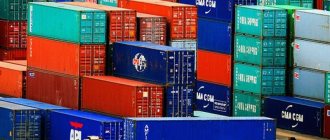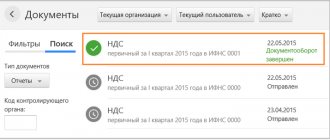Import is the import of products into the Russian Federation from abroad, and export is the sale of products to foreign contractors and their export abroad. Both operations require special accounting.
Question: We import goods and carry out voluntary certification before selling them. Can we take into account these costs as expenses for profit tax purposes, taking into account the fact that these are not our products and certification of this product is not required? View answer
Features of accounting for import transactions
Keep records of exports and imports using the simplified tax system in the Kontur.Accounting web service.
Currency accounting and work instructions, taxes, automatic payroll calculation and reporting in one service Get free access for 14 days Firstly , import transactions are carried out in foreign currency. For accounting purposes, it is important to correctly convert it into rubles. Conversion occurs at the rate of the Central Bank of the Russian Federation, which changes daily, so exchange rate differences arise.
The difference can be positive or negative. A positive one is formed if you received income from a change in the exchange rate, a negative one - vice versa.
Secondly , taxation and customs duties. In addition to taxes in accounting, carry out operations to pay customs duties and fees, which are included in the cost of the purchased goods (clause 6 of PBU 5/01).
Thirdly , the formation of the cost of goods. In accordance with clause 6 of PBU 5/01, in addition to customs duties, fees and taxes, the cost of imported goods includes:
- directly the amount under the contract;
- amounts to third parties for consultations and services (for example, customs brokerage services);
- delivery costs;
- intermediary remuneration;
- and other costs.
You also encounter other operations on the domestic market - settle payments with a counterparty, pay value added tax, capitalize goods, refund VAT.
Incoterms 2021 provisions
It is a set of eleven rules applied in international trade, reflecting the rights and obligations of each party to the contract in relation to the delivery of goods from the seller to the buyer. Incoterms 2021 rules are in effect from 1 January 2021, but earlier versions can also be used. They reflect current trade practices around the world. The main purpose of this set of rules is to simplify the understanding of a foreign trade contract, distribute obligations and expenses between the parties to the transaction (payment for transportation, costs for customs reporting and duties, transfer of ownership and risks of loss, etc.). Contains 4 groups of basic delivery conditions (table):
| Delivery conditions | Description | Transfer of risks to the buyer | Cost of goods, invoice | |
| Group E (shipment) | ||||
| EXW | The products are placed at the disposal of the buyer directly at their warehouse or enterprise. Literally translated as “ex-warehouse”, actually means pick-up | At the time of shipment at the seller's warehouse | Product cost without additional costs | |
| Group F (when the main transportation costs are borne by the buyer) | ||||
| FCA | The products are transferred to the buyer, loaded onto a specific vehicle at a pre-agreed location and released by customs according to the export procedure. The seller pays basic customs duties. The buyer completes import customs clearance. | At the time of loading onto a vehicle (at the seller’s warehouse or when transferring the goods from the seller’s transport to the carrier) | Cost of goods and cost of export clearance with payment of customs duties, but without transportation costs | |
| F.A.S. | The buyer is handed over the products placed along the ship's side, released by customs under the export procedure. The seller bears the costs of export clearance and duties. The buyer bears the costs of loading the goods on board the vessel, transportation and import customs clearance. Applicable only for transportation by water transport. | At the time of unloading of goods at the side of the vessel (in the absence of a vessel, the shipment is not considered completed) | The cost of the goods, taking into account export clearance and payment of appropriate duties, the cost of delivery to the port of shipment and unloading at the pier. Does not include transportation and freight costs | |
| FOB | It differs from FAS in that the seller is obliged to load the goods onto the ship and secure them. Also used for transportation by water. | At the time the goods are placed on board the vessel. | Same as FAS. Additionally, the costs of loading the goods onto the ship are included. Freight cost does not include | |
| Group C (the main transportation costs are borne by the seller) | ||||
| CFR | The seller places the goods on the ship, completes the export customs procedure, and pays the appropriate export duties and freight costs. The buyer bears the costs of transportation and unloading at the port of arrival, and completes import customs clearance. Transportation by water transport only | In this case, the risk of loss or damage passes to the buyer at the moment the goods are placed on the ship. Although the shipping costs are borne by the seller | Same as FOB, also freight costs. Unloading at the port of destination is paid by the buyer | |
| CIF | It differs from CFR in that, among other things, the seller is required to insure the products sold. Exclusively transport by water transport | At the time of placement on board the vessel. Despite the seller paying for shipping and insurance. | Additionally, the cost of insurance of the goods is included in the price. | |
| C.I.P. | The seller pays for transportation of the goods to the designated point, insurance, and export customs duties. Import customs clearance and unloading remains with the buyer. Changes to Incoterms 2021: the amount of the insured amount has been increased to 110 percent of the value of the insured amount of the goods | At the time of delivery of the goods to the carrier | Final cost of products + costs for export clearance and payment of export customs duties + insurance + delivery to destination | |
| CPT | The seller bears the costs of freight/transportation, export customs clearance and duties. The buyer completes import customs clearance and bears the unloading costs. | At the time of delivery of the goods to the carrier. Risks on the goods and costs pass to the buyer in 2 different places | Is the same | |
| Group D (delivery) | ||||
| DAP | The buyer bears the costs of unloading. Risks and expenses are transferred to the seller in one place | The transfer of risk to the goods passes at the destination | Cost of goods, export duties and clearance, transportation of goods to destination | |
| DPU | It differs from DAP in that the seller is obliged to unload the goods at the destination. These are the only conditions when unloading is carried out by the seller | At the time of delivery to the seller after unloading at the designated place. | The same + costs for unloading goods | |
| DDP | The seller hands over the products to the buyer at the destination, ready for unloading. Moreover, export and import customs clearance and payment of duties also lies with the seller. The buyer bears the costs of unloading the goods. | Risks pass to the seller until unloading at destination. | Cost of goods + customs clearance costs + payment of duties and taxes + costs of delivery to destination and unloading | |
VAT on imports: what you need to know
The Tax Code of the Russian Federation does not make any special differences in taxation between domestic sales and imports: rates of 20 and 10 percent are applied (if the sale of such goods on the territory of the Russian Federation is taxed at the appropriate rate). However, remember that you will have to pay VAT at customs, because without this, the goods will not be released from the temporary storage area at customs. For late payment, be prepared to incur penalties.
Differences in accrual begin from the moment of the tax base - when importing goods, include, in addition to the cost of the product according to the declaration, also customs duties and excise taxes.
You can deduct import VAT. To do this, you must pay tax at customs and confirm the costs incurred for the purchase with the appropriate documents.
SYSTEM: VAT cannot be deducted. The tax amount is included in the cost of the goods under the object of taxation “Income” or is included in the composition of expenses during taxation under “Income minus expenses”.
This type of operation is the exact opposite of import: goods are exported from the country, and there is an obligation to declare the goods and pay customs duties.
Accounting for export transactions should be kept separately from other sales transactions, since they are subject to a special VAT rate.
Let us highlight some accounting features:
- All payments are made both in rubles and foreign currency. To do this, the company must open foreign currency accounts in a bank and keep accounting using account 52 - create your own sub-account for each currency. Exchange differences are usually taken into account as part of other income and expenses.
- The transfer of ownership often does not coincide with the date of shipment of the goods. It all depends on what rules according to Incoterms 2021 were defined in the contract. Important! All conditions of export deliveries should be specified in the contract as precisely as possible - this will avoid most mistakes.
- In essence, sales transactions do not differ from the option of selling goods on the territory of our country.
To facilitate accounting, export sales transactions can be accounted for in separate subaccounts. Since customs duties must also be paid when exporting and declaring goods, specific transactions are added, such as:
| accounting entry | Operation |
| Debit 45 Credit 41 | Products were shipped from the supplier's warehouse, ownership has not been transferred |
| Debit 90 Credit 45 | Revenue recognition. Transfer of ownership according to the terms of the contract. |
| Debit 20, 44 Credit 76 | Duties on export transactions and customs declaration costs have been accrued |
| Debit 76 Credit 51, 52 | Customs duties (duty) paid |
Accounting for the reflection of export VAT deserves special attention. The company has the right to apply a 0 percent rate. But only if the company can confirm the right to use it. To do this, provide the following documents to the tax authorities:
- contract with a foreign counterparty;
- an extract from a credit institution confirming receipt of funds in payment for the delivery;
- a copy of the customs declaration with notes from the customs inspector;
- copies of other documents to confirm export.
For everything – a period of 180 calendar days. Did not have time? The company loses the right to apply a zero rate for export operations. Therefore, you will have to recalculate the tax amount at a rate of 20 percent (10 percent for certain types of goods according to the Tax Code of the Russian Federation).
VAT on advances. In this case, you must pay VAT on the amount of the advance received. Request a refund of the amount paid once title has passed to the buyer. A separate tax return is submitted for this purpose.
Tax deductions. The amounts of tax on advances made by foreign buyers, as well as the amounts of VAT that were paid to counterparties in the production of export goods, are subject to deduction. The right to deduction arises either on the last day of the quarter in which you collected documents confirming the zero rate, or on the day of shipment of the goods, if the special rate is not confirmed.
Important!
It is mandatory to keep separate records of input VAT on external and internal transactions!
Export VAT: postings
| accounting entry | Operation |
| Debit 19 Credit 60 | Input VAT on exports taken into account |
| Debit 90 Credit 68 | VAT is charged on sales at a rate of 0 percent |
| Debit 68 Credit 19 | Input VAT is accepted for deduction. |
| Debit 90 Credit 68 | If the zero rate is not confirmed within the prescribed period, then VAT on sales should be charged at the current rate of 20 (10) percent |
Income tax – when to report revenue?
If income is recorded on a cash basis, then accordingly, we recognize revenue on the date of receipt of funds in a foreign currency account. Do not forget to recalculate it in rubles at the current exchange rate for the currency in which settlements with the foreign buyer are made.
However, most companies use the accrual method, which is where positive and negative exchange rate differences arise due to currency fluctuations. Reflect them as non-operating income/expenses when forming the tax base.
In order to comprehensively solve all problems related to foreign exchange transactions, you can automate the accounting of export-import transactions. Solutions such as “1C:ERP Enterprise Management”, “1C:Holding Management”, “1C:Accounting” and others will help with this. Find out more about the products here >>>
Accounting entries for import transactions
Let's look at the basic accounting entries accompanying the import of goods using an example. On February 22, 2021, Mister LLC purchased 10 refrigerator-freezers with a capacity of 350 liters each. from a foreign partner at a price of $5,000. Simultaneously with the purchase, Mister LLC received ownership of the goods. The exchange rate of the Central Bank of the Russian Federation as of February 22, 2019 is 65.54 rubles. We paid for the goods on 03/07/2019 at the rate of 64.50 rubles. Customs duty is 10,000 rubles.
The question arises - how to find out the customs duty rate? To do this, we find the code of the commodity nomenclature of foreign economic activity (HS code), which is suitable for our cargo. This code is 8418102001. For goods falling under this code, the import duty is 12%. Read about how to determine the Commodity Nomenclature for Foreign Economic Activity code in the articles “Handbook of Commodity Nomenclature for Foreign Economic Activity” and “Code of Commodity Nomenclature for Foreign Economic Activity”.
To complicate matters, we add that the customs clearance was handled by a customs broker. His services cost 35,000 rubles.
Keep records of exports and imports using the simplified tax system in the Kontur.Accounting web service. Currency accounting and work instructions, taxes, automatic salary calculation and reporting in one service Get free access for 14 days
As a result, we generate the following postings. Confirm all transactions with documents.
| Dt | CT | Sum | Description |
| 08 | 60 | 5000*65.54 = 327,700 rub. | Imported refrigerators were capitalized |
| 19 | 68 | 5000*65.54*1.12*0.20 = 73,404.8 rubles. (customs duty is included in the price when calculating VAT!) | Import VAT charged at 20% |
| 08 | 76 | 327,700*0.12 = 39,324 rubles. | Customs duty charged |
| 08 | 76 | 10,000 rub. | Customs duty charged |
| 08 | 60 | 35,000 rub. | Accrued costs for customs brokerage services |
| 60 | 52 | 5,000*64.50 = 322,500 rubles. | Payment was transferred to a foreign counterparty for refrigerators on 03/07/2019. |
| 60 | 91 | 5,000*(65.54-64.50) = 5,200 rub. | A positive exchange rate difference is reflected, because in rubles they paid an amount less than it was at the time the contract was concluded |
| 76 | 51 | 10,000+39,324 = 49,324 rubles. | Customs duties and fees have been paid |
| 60 | 51 | 35,000 rub. | Paid brokerage services |
| 68 | 51 | RUB 73,404.8 | Import VAT paid |
| 01 | 08 | 327,700+10,000 + 39,324 + 35,000 = 412,024 rubles. | Refrigerators are accepted for accounting as fixed assets |
| 68 | 19 | RUB 73,404.8 | Import VAT accepted for deduction |
Read more about VAT refunds on import transactions in our article.
VAT reflection
The accountant must pay attention to accounting for VAT transactions. This need is due to the fact that the company can use a 0% rate. The accountant needs to develop a procedure for distributing VAT on indirect expenses and prepare all important tax documents. VAT on export expenses is summed up on account 19. In this case, separate accounts are allocated.
Let's look at the wiring used:
- DT19 KT60. VAT on export expenses.
- DT19 KT68. Restoration of tax that was previously accepted for deduction. The entry is made on the date of shipment of the product.
- DT19 CT19. Tax on indirect expenses.
- DT68 KT19. Tax write-off on confirmed transactions.
- DT19 KT68. Taxes on unconfirmed exports.
- DT68 KT19. Deduction of tax previously assessed on unconfirmed exports.
- DT91 KT68. Calculation of VAT fines.
- DT91 KT19. Writing off tax as other expenses when the transaction remains unconfirmed.
IMPORTANT! The peculiarities of export accounting are determined by the special taxation procedure and the risk that export accounts may be unclaimed.
Common Mistakes
Keep records of exports and imports using the simplified tax system in the Kontur.Accounting web service. Currency accounting and work instructions, taxes, automatic salary calculation and reporting in one service Get free access for 14 days
Control over foreign economic activity by the state is stronger than over internal activities. Therefore, avoid mistakes when maintaining accounting records of import transactions. Check the following points:
- currency conversion - often accountants use the exchange rate on an incorrect date;
- translations of documents - import documents must be in two languages: Russian and the partner’s language, sometimes the partner sends documents only in his own language, then you need to prepare a translation;
- correspondence of accounts - an error typical for internal and external activities; it is eradicated with increasing experience of the accountant.
Primary documents for accounting
The most difficult thing when managing imports is the determination and calculation of cost.
In this case, you need to take into account the costs of customs clearance, taxation, duties, and logistics costs. In addition to calculating the cost, there are a number of mandatory primary documents that must be filled out competently and correctly.
Agreement, contract
This is the main document on the basis of which cooperation with foreign partners is carried out. It is in this document that all the terms of cooperation, payment procedures, and delivery times are spelled out. The agreement should also spell out the risks of both parties and how they will be compensated in case of unforeseen situations.
Invoice
This is a document that is drawn up by the seller for the buyer. This document reflects all the qualities and properties of the product being sold. It is required to pass customs control, as well as to check currency transactions.
Customs declaration
This document is required for registration of transactions both for import from foreign countries and for export.
To be filled in by the manager of the goods being sold. A properly and correctly completed declaration guarantees the legality and legality of the transaction. If everything complies with the requirements and norms of current legislation, the inspector certifies the declaration. The declaration must contain information about the product, its quantity, seller, buyer, delivery features, amount of fees, duties, VAT, customs value. When filling out, it is worth considering that all documents are drawn up in two copies. One of them is in Russian, the second is in the language of the foreign partner who supplies its products to the country.
Import documentation
Keep records of exports and imports using the simplified tax system in the Kontur.Accounting web service. Currency accounting and work instructions, taxes, automatic salary calculation and reporting in one service Get free access for 14 days
To generate accounting entries, successfully pass customs authorities and receive a VAT refund, prepare the following documents:
- foreign trade contract with a foreign counterparty;
- invoice from the seller - invoice or invoice;
- transport documents;
- documents confirming cargo insurance;
- customs declaration for goods - after passing customs you will be given it with the stamp of the authority;
- receipts and payment orders confirming the fact of payment of duties, fees and taxes;
- technical documentation;
- acts of acceptance and transfer;
- licenses and certificates as required.
You can familiarize yourself with documents on foreign economic activity in the article “Documents for foreign economic activity.”
Opening a foreign currency account
It is not profitable for foreigners to work with rubles, so most often payment for a foreign contract takes place in foreign currency. To do this, you need to open a foreign currency account in any bank convenient for you and buy currency. This procedure is simple; all you need to do is provide the bank with all the necessary documents.
A foreign currency account is opened in a bank on the basis of a banking agreement, and for the purchase of currency an application is drawn up in the form approved by the bank. The required amount to purchase currency is transferred from your current account. If the foreign currency account is in the same bank as the current account, then you can indicate the details of your current account in the application and the funds will be debited from it.
Right to deduction
The amount of VAT paid upon import is taken as a deduction or taken into account in the cost of the goods. The right to deduction arises only for VAT payers subject to the conditions provided for in paragraph 2 of Article 171 and paragraph 1 of Article 172 of the Tax Code of the Russian Federation. In this case, the deduction can be claimed in tax periods within three years after the registration of goods imported into the territory of the Russian Federation and other territories under its jurisdiction. Please note: persons exempt from fulfilling the duties of a VAT payer, as well as persons using special regimes, despite paying import VAT, are not entitled to apply a deduction. Companies that use imported goods in transactions not subject to VAT also do not have the right to deduction. In these cases, the tax amount is taken into account in the cost of goods. When applying a deduction, VAT payers register a customs declaration and other supporting documents in the purchase book, that is, an invoice is not required to apply the deduction in this case.
Certification costs
Taxpayers using the simplified tax system have the right to reduce the income received by expenses for confirming the compliance of products or other objects, production processes, operation, storage, transportation, sales and disposal, performance of work or provision of services with the requirements of technical regulations, provisions of standards or terms of contracts.
Thus, when determining the tax base for the tax paid in connection with the application of the simplified tax system, the taxpayer has the right to reduce the income received by him for the costs of certification of imported goods.
The specified expenses are accepted after the completion of certification work (signing of the certificate of completion) and their payment (clause 2 of Article 346.17 of the Tax Code of the Russian Federation, letter of the Ministry of Finance of Russia dated December 26, 2006 N 03-11-04/2/293, Federal Tax Service of Russia for the city of Moscow dated February 16, 2009 N 16-15/013702).
The amount of customs security in accounting
Good afternoon While activists or staff forum experts have not answered your question, look at the materials that were automatically found on the topic of your question. Perhaps they will be useful to you. After viewing the materials, please answer the question whether this information helped you. If the information helps, click “Yes.” If the links are not useful, click "No". News and articles Income tax disputes: what conclusions did the courts come to this spring June 21, 2013 The Tax Code was amended related to electronic document management, relations with banks and accounting reports July 31, 2012 Review of arbitration practice for August and early September 2011 October 17, 2011 How to calculate market prices according to the new rules September 6, 2011 Questions on the forum How to reflect the amount of security for customs payments in accounting? December 29, 2015 Accounting for individual entrepreneur expenses on the simplified tax system (income minus expenses) June 11, 2021 Where to start processing an export transaction? May 23, 2021 Can goods written off for domestic consumption be taken into account in expenses in KUDiR under the simplified tax system (15%)? May 17, 2021 Answers from officials Property tax and transport tax March 30, 2016
Currency control
And although the transaction passport was cancelled, currency control has not gone away. The bank can still request supporting documents from you for transactions over 200 thousand rubles in ruble equivalent. Therefore, save all contracts, transaction passports and other documents with information about currency transactions. The full list of documents that you may be asked to provide is contained in the law.
Banks charge a commission for currency control services and agreement registration. Everyone's conditions are different, so check in advance what the conditions are at your bank.
Postings and operational accounts for customs duties for exports
What are wiring? This is an accounting term that means recording various changes in the condition of a particular product in the documentation.
To what account should customs payments be attributed when exporting products? When exporting goods outside the territory of the state, the procedures are written off from account 90, subaccount 5 to account 76. The procedure is documented by posting D90/5 K76.
As a rule, when exporting products, the VAT rate is 0%. In other words, the foreign trade participant receives compensation from the state budget for repayment of this payment. But there are some exceptions for such cases:
- sales and delivery of products are carried out in the Republic of Belarus;
- export of petroleum products.
To receive reimbursement for VAT expenses, you must provide the government agency with the following basic documents:
- a contract concluded between a foreign trade participant and a foreign representative;
- a document from a banking organization confirming a financial transaction;
- cargo customs declaration.
The payer must comply with the deadlines for submitting documents. They are 180 days after drawing up the declaration.
After submitting the required package of documents to the customs authority, VAT refund is carried out within 3 calendar months.
Determining the rate
The VAT tax rate depends on the type of imported goods and is 10 or 18 percent. The rate must be determined as follows: according to the commodity nomenclature of foreign economic activity of the Eurasian Economic Union (TN FEA EAEU) and the All-Russian classifier of products by type of economic activity, approved by Order of Rosstandart of January 31, 2014 No. 14-st, you need to find the code of the imported product. It must then be compared with product codes for which a 10 percent VAT rate applies. If the product code is present in the specified lists, then a rate of 10 percent is applied, otherwise - 18.










